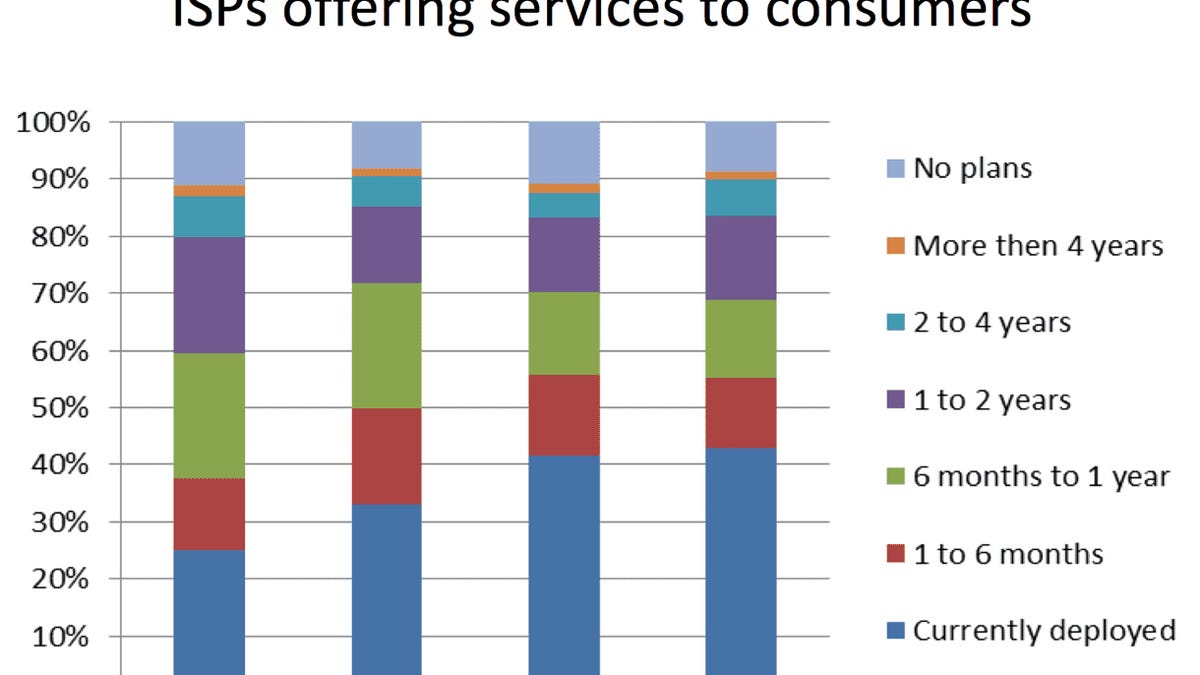ISPs warm to IPv6, but old-era Internet plumbing persists
The next-generation Internet technology is catching on among ISPs and their customers, but efforts to squeeze more life out of IPv4 persist, a survey finds.

Internet service providers are gradually warming to IPv6, the technology for a vastly more capacious Internet, but there are also signs of a technique to extend the useful lifespan of IPv4.
IPv4 has served the Net well, but it doesn't have enough addresses for all the world's devices. IPv6 opens the doors for uncountable numbers of devices, but the transition to support it has dragged on for years. A survey by the Number Resource Organization (NRO), a group that represents several central powers that allocate Internet address, shows that ISPs are slowly getting IPv6 religion.
Of 646 ISPs in the survey, 72 percent are considering promoting IPv6 to their customers this year, according to the survey, released Monday. That's up from 63 percent in 2011 and 2012 and 58 percent in the 2010 survey.
Customers are taking advantage of the services, too, though IPv6 data is still only a small fraction of total Internet traffic. In 2010, 60 percent of ISPs said none of their customers use IPv6 connectivity. That's now down to 35 percent. Conversely, the percentage of ISPs that said more than one in fifty of their customers use IPv6 has increased from about 3 percent in 2010 to about 12 percent in 2013.
"While a small minority is still banking on their stock of IPv4 addresses for the years to come, most recognize the importance of transitioning to IPv6," the survey concluded.
About 43 percent of ISPs offer IPv6 services now, up from 25 percent in 2010.
Under the Internet Protocol, every device that attaches to the Net gets an IP address that's used to route data to and fro. IPv4 offers only 4.3 billion addresses (2 to the 32nd power, or 4,294,967,296, to be precise). That may sound like a lot, but there are ever more devices to connect to the Internet, and many of the IPv4 addresses are squirreled away inaccessibly by organizations that got them in bulk earlier in the history of the Internet.
In contrast, IPv6 offers 340 undecillion addresses (2 to the 128th power, or 340,282,366,920,938,463,463,374,607,431,768,211,456, to be precise). But because supporting IPv6 requires lots of new hardware, software, and testing, the computing industry has moved to it only very slowly.
The survey also dug into another option for dealing with IPv4 address space exhaustion: carrier-grade NAT, or network address translation. NAT lets multiple devices share the same IP address through coordination by the network equipment that manages their connection to the Net, and carrier-grade NAT takes that approach at a very large scale. Carrier-grade NAT (CGN) is thus also called large-scale NAT (LSN).
The number of companies in the survey -- in this case, not just ISPs -- using CGN increased from 6 percent in 2012 to 8 percent in 2013, and the number of companies planning to use it increased from 9 percent to 10 percent.
However, for most respondents, CGN isn't a substitute for IPv6 support. In 2013, 92 percent of those planning to use CGN plan to do so in addition to IPv6. Of those actually using it, 71 percent do so it in addition to IPv6.
"Carrier-grade NAT is generally not used as a solution to replace IPv6," the survey concluded.
Overall, the switch to IPv6 is mostly inevitable as the world runs out of IPv4 addresses.
One big IPv6 moment was World IPv6 Day in 2011, when major sites such as Facebook and Google enabled their sites over IPv6. The next year, the switched on the IPv6 sites and left them on permanently.

